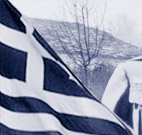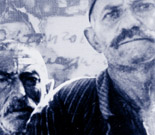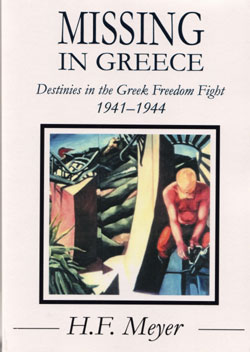 |
 |
 |
 |
 |
 |
 |
 |
|||||||||
|
|
||||||||||||||||
In the night of 25th November 2002, it will be sixty years since the Gorgopotamos bridge on the Brallos pass (Thermopylae) in Greece was blown up. Twelve members of the Commonwealth army and 150 Greek freedom fighters, called andartes, carried out this spectacular feat at a time when Greece was occupied by German, Bulgarian and Italian troops. This operation was to have extensive consequences for the course of the war in the Balkans. The destruction of the bridge is celebrated to this day like a national holiday. SOE Cairo, the secret command centre for subversive action, parachuted the Commenwealth commandos into the difficult terrain in Central Greece in October 1942 under the leadership of Colonel E.C.W. (Eddie) Myers. Their task as “Operation Harling” was to destroy one of three railway viaducts on the line between Thessaloniki and Athens in order seriously to disrupt vital supplies getting through to Rommel’s troops in Africa. Within four weeks the commandos were able to carry out the operation. They were supported by the andartes who were so-called guerrilla bands led on the one hand by Kapetanios Aris Velouchiotis of the leftwing ELAS and on the other hand by a former officer of the Greek army, Napoleon Zervas, commander of the rightwing EDES. News of the successful destruction of the viaduct ran like wildfire through Greece. Hundreds of young men and former soldiers and officers of the Greek army went to the mountains to volunteer for the andartes. Initially the twelve British commandos were supposed to be brought back to Africa. However, evacuation became impossible, so SOE headquarters in Cairo ordered them to stay in the Greek mountains as liaison officers and to train the rapidly growing number of andartes in partisan warfare and to equip them with money and weapons. The author’s father was the paymaster of the German unit of Railway Engineers assigned to reconstruct the 211 metre long viaduct after it was blown up. Meanwhile, Rommel had lost the battle at El-Alamein, but troops in Southern Greece still needed to be supplied. In the interim supplies were transported by sea and then taken laboriously over narrow mountain passes by lorry or mules. Rail traffic was re-started on 5 January 1943 as soon as the twisted metal piers had been replaced by wooden scaffolding. Up to that time, the andartes in Central Greece had attacked only Italian troops. At the end of March 1943, however, with the support of the British, they felt strong enough to tackle German troops directly. This decision, taken by the Central Committee of the Communist Party of Greece (KKE), was announced by Tasos Lefterias, Velouchiotis’ second-in-command, to the leadership of ELAS when they were gathered in the village of Marmara near Lamia on the Greek national day ( March 25). Several days later, the author’s father and 33 German and 16 Italian soldiers and civilians were captured by ELAS freedom fighters and locked in a school house in Kolokythia, a village high up in the mountains near Lamia. The author’s father was the only officer among them. German and Italian troops hunted for the missing men, burned down many villages in the Sperchios valley, terrorised the civilian population and took over 600 hostages in reprisal. The three leaders of ELAS, Aris Velouchiotis, Andreas Tzimas and Tasos Lefterias then decided to execute the German prisoners. However, they first gave them the option that they would not be shot if they joined the andartes. Two Germans accepted the offer, and one of them actually returned to Germany in 1948. The remaining 32 Germans were shot but all the Italians were set free. The Germans were declared missing by the Wehrmacht and again, after the war, by the Red Cross. Twenty years after the news that his father was missing, the author travelled to Greece to find out what had actually happened. He then reconstructed the events based on documents he found in German, Italian, Greek and British archives and over two-dozen relevant books published in England, New Zealand and Greece after the war. In addition, he interviewed the responsible British, New Zealanders, Germans and Greeks – and amongst them the man who shot his father. H.F. Meyer’s book entitled Vermisst in Griechenland. Schicksale im griechischen Freiheitskampf 1941-1944 was published on the fiftieth anniversary of the destruction of the Gorgopotamos bridge. The book contains several facsimiles and unique photos. Although it is out of print, the author can supply specimen copies (e-mail: ). In 1995 the book was published in Greece [H ANAZHTHSH (Athens: Kalentis, 1995) (e-mail: kalendis@ath.forthnet.gr)] and in Great Britain [Missing in Greece. Destinies in the Greek Freedom Fight 1941-1944, London: Minerva Press, 1995 (e-mail: mail@minerva-press.co.uk)]. A second edition was published in 1998. The book found considerable resonance in these countries and was very positively reviewed because of "the objective and exciting description of the tragic events". |
        |
|||||||||||||||
|
||||||||||||||||
